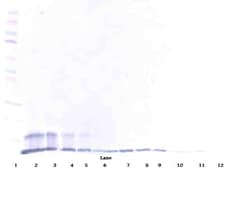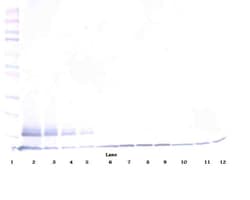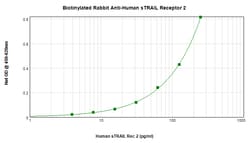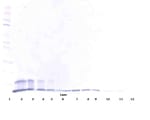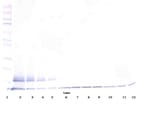Learn More
Invitrogen™ TRAIL-R2 (DR5) (soluble) Polyclonal Antibody, Biotin, PeproTech®, Invitrogen™ 
Rabbit Polyclonal Antibody
Supplier: Invitrogen™ 500P299BT50UG
Description
AA Sequence of recombinant protein: MESALITQQD LAPQQRVAPQ QKRSSPSEGL CPPGHHISED GRDCISCKYG QDYSTHWNDL LFCLRCTRCD SGEVELSPCT TTRNTVCQCE EGTFREEDSP EMCRKCRTGC PRGMVKVGDC TPWSDIECVH KES. Preparation: Produced from sera of rabbits immunized with highly pure Recombinant Human sTRAIL Receptor-2. Anti-Human sTRAIL Receptor-2-specific antibody was purified by affinity chromatography and then biotinylated. Sandwich ELISA: To detect hsTRAIL Receptor-2 by sandwich ELISA (using 100 μL/well antibody solution) a concentration of 0.25-1.0 μg/mL of this antibody is required. This biotinylated polyclonal antibody, in conjunction with PeproTech Polyclonal Anti-Human sTRAIL Receptor-2 (500-P299) as a capture antibody, allows the detection of at least 0.2-0.4 ng/well of Recombinant hsTRAIL Receptor-2. Western Blot: To detect hsTRAIL Receptor-2 by Western Blot analysis this antibody can be used at a concentration of 0.1-0.2 μg/mL. Used in conjunction with compatible secondary reagents the detection limit for Recombinant hsTRAIL Receptor-2 is 1.5-3.0 ng/lane, under either reducing or non-reducing conditions. 500-P299BT-1MG will be provided as 2 x 500 μg
DR5 (Apo2, TRAIL-R2, TRICK2, KILLER) is a recently identified death domain containing receptor for TRAIL, which mediates TRAIL induced apoptosis. DR5 is a member of the TNF-receptor superfamily, and contains an intracellular death domain. DR5 can be activated by tumor necrosis factor-related apoptosis inducing ligand (TNFSF10/TRAIL/APO-2L), and transduces an apoptosis signal. Studies with FADD-deficient mice suggested that FADD, a death domain containing adaptor protein, is required for the apoptosis mediated by DR5. Two transcript variants encoding different isoforms of DR5 and one non-coding transcript have been found. Overexpression of DR5 induces apoptosis and activates NF-kappa-B. DR5 is expressed in a number of cell types, and to particularly high levels in lymphocytes and spleen. Diseases associated with DR5 dysfunction include squamous cell carcinoma, and diffuse infiltrative lymphocytosis syndrome.Specifications
| TRAIL-R2 (DR5) (soluble) | |
| Polyclonal | |
| Biotin | |
| TNFRSF10B | |
| apoptosis inducing protein TRICK2A/2B; apoptosis inducing receptor TRAIL-R2; CD262; cytotoxic TRAIL receptor-2; death domain containing receptor for TRAIL/Apo-2L; death receptor 5; Dr5; dr-5; Fas-like protein; KILLER; KILLER/DR5; KILLER/DR5 TRAIL death-inducing receptor; Ly98; MK; p53-regulated DNA damage-inducible cell death receptor(killer); sCD262; soluble CD262; TNF receptor superfamily member 10b; TNF-related apoptosis-inducing ligand receptor 2; TNFRSF10B; TRAIL receptor 2; TRAILR2; TRAIL-R2; TRICK2; TRICK2A; TRICK2B; TRICKB; tumor necrosis factor receptor superfamily member 10B; tumor necrosis factor receptor superfamily, member 10b; tumor necrosis factor receptor-like protein ZTNFR9; UNQ160/PRO186; ZTNFR9 | |
| Rabbit | |
| Antigen affinity chromatography | |
| RUO | |
| 8795 | |
| -20°C | |
| Lyophilized |
| ELISA, Western Blot | |
| 0.1-1.0 mg/mL | |
| PBS with no preservative | |
| O14763 | |
| TNFRSF10B | |
| E.coli-derived, 14.9 kDa Recombinant Human sTRAIL Receptor-2. | |
| 50 μg | |
| Primary | |
| Human | |
| Antibody |



